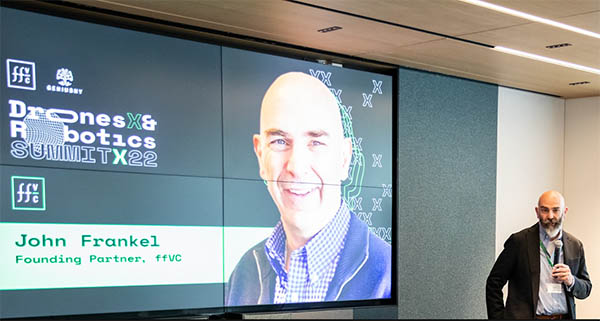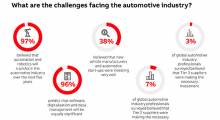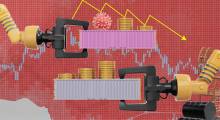Chicken Little blog missives have inundated Medium’s site lamenting the stock market’s decline. Since joining ff Venture Capital’s partnership this summer, I’ve been awestruck by the level of optimism that permeates the organization.
While others are now constricting their activities, ffVC is plowing ahead by closing its seventh fund and launching an eighth one for Ukrainian startups. Kicking off ffVC's second annual Drones & Robotics Summit last month in New York, Founding Partner John Frankel conveyed this enthusiasm to a packed house of 300 tech luminaries.
Frankel’s confidence has been fostered by more than 15 years of portfolio management experience with both fair weather and stormy seas, while at the same time hooking the next billion-dollar opportunities. As I review three big takeaways from the summit, each reverbarates the same chord – automation is on the upswing, despite grim financial news.
1. COVID has a multiplier effect
While the S&P 500 has declined over 20% since January 2022, the robotics market has climbed close to 45% over the same period. As a result, The New York Times recently reported that manufacturing in the U.S. added a net gain of 67,000 workers over pre-pandemic levels for the first time since the 1970s. The Times suggested that this uptick is in large measure in response to supply chain issues with China and localizing inventories with new “grey-collar” jobs managing robots.
I think Erik Nieves, CEO of Plus One Robotics, said it best at the summit: “Well, it was clear that there was not going to be enough labor to manage all of the deliveries and the packaging as we continue to move our commerce online.”
“But COVID acted as an accelerant to all of that, because right when we had the most need for the parcels and orders to flow is when we had the least reliable labor to do it,” he added. “And so we have seen an important growth in the business just predicated on that. It’s not as if we were not going to get there eventually, but certainly, COVID had the effect of pulling forward three years’ worth of growth all at once. And you are going to see that writ large everywhere automation can play a role.”
Miika Satori, co-founder of leading computer vision company Cambrian, shared Neives’ sentiment for the greater smart manufacturing space as well. Since the pandemic, the Industrial Internet of Things (IIoT) market has filled a critical void left by labor and supply chain shortages. It has provided startups rich opportunities to introduce technologies for a variety of operations leveraging computer vision, data science, machine learning, and 3D printing.
Mechatronic systems using deep learning can now be applied to command-and-control hardware, offering the most scale and attractive margins for early stage investors. This conviction is further validated by the recent study that projects the smart manufacturing market to climb to $727 billion in 24 months.
Panel on “Optimizing the Workflow” moderated by Oliver Mitchell, ffVC, with Miika Satori, Cambrian Intelligence; Jessica Lee, Increment; Erik Nieves, Plus One Robotics; and Youssef Saleh, Ava Robotics.
2. Drone delivery is happening now
The pandemic also propelled delivery services to new heights and drove a $190 billion global online food delivery marketplace in 2021. UberEATS, DoorDash, and Wolt, among others, have been satisfying urbanites’ cravings by using bike and moped messengers for deliveries within minutes.
However, this convenience comes at the cost of increased traffic congestion and mounting pedestrian/cyclist injuries. Unmanned aerial vehicles (UAVs) or drones offer the promise of sustainable infrastructure, lower costs, greater vehicular safety, and higher customer satisfaction.
While UAVs sound like science fiction to many outsiders, Alan Hicks, chief technology officer of Manna Drone Delivery, said his company is making it a reality today. Manna has over 35,000 grocery and pharmacy customers in Ireland. Hicks’ experience is further substantiated by a recent study that projects the drone logistics and transportation market to grow from $539 million today to $17 billion in eight years.
Alan Hicks of Manna Drone Delivery described how people are using his service to order groceries, pharmaceuticals, and even coffee.
In addition, opportunities for terrestrial roboticists include autonomous delivery fleets, unmanned rovers, and robotaxis over the next five years, leading to a wider $120 billion market opportunity. Integrating drones into the national airspace falls on the lap of NASA's Star Ginn, who is actively working to turn the promise of efficiency into actionable steps towards full autonomy.
“We have this roadmap right now at NASA to start closing the loop on the system where machines and machines are negotiating that sort of scale, and we will just keep adding more complex situations,” explained Ginn. “So It’s not just to show it works on a nominal day; what we are looking at is how we stress the system on all the off-nominals.”
This public/private partnership is best illustrated in upstate New York with the Genius New York accelerator and NUAIR advancing drone startups from a napkin drawing to actual deployments in the skies.
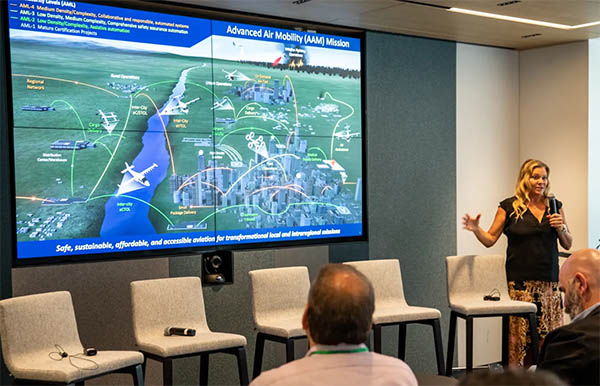
3. Robots are filling lost jobs
Last November, the U.S. Congress passed an infrastructure spending bill that has allocated $1.2 trillion to investments in roadways, renewable energy, and other large public works projects over the next 10 years. These large capital outlays, coupled with the loss of skilled labor post-pandemic, have accelerated the push for unmanned equipment.
Today, the demand for highly skilled construction workers exceeds the supply of people ready to fill these jobs, exacerbating the push for mechanized job sites. While global infrastructure spending is climbing to over $3 trillion, the number of skilled tradesmen is rapidly declining.
For example, the Bureau of Labor Statistics reported that of the 65,000 people currently working in America as surveyors, cartographers, and photogrammetrists, with just 9,000 under the age of 34. This means that there is a shortage of new skilled workers replacing retirees at alarming rates. This labor void has provided automation startups a $12 billion market opportunity by 2026.
Explaining the post-pandemic lift for his business, Liav Muller, co-founder of Civ Robotics, shared with the Summit how his large construction clients are calling him with a sense of urgency now to fill lost jobs.
Charlie Anderson, CEO of Burro, which has developed an autonomous towing robot for fruit orchards, agreed. He noted the challenges of increasing population density, higher food production, and that no one under the age of 50 wants to pick crops anymore. This is what is driving a $135 billion autonomous farming equipment market globally.
The push toward automation has been accelerated by the post-pandemic labor crunch and supply chain shortages. According to NBC News, U.S. farmers in September reported labor shortages as high as 20%, leading to a 10% increase in the cost of food.
Beyond the inflationary concerns, the entire food supply is at risk of crumbling, prompting investments by the federal government and large manufacturers like John Deere to accelerate the adoption of autonomous tractors and harvesters.
While corn and grain fields have been mechanized over the past 10 years, orchards, berry, and nut production have been historically ignored by these types of initiatives. Startups like Burro are taking industrial automation to farms to take over most of the backbreaking and tedious jobs, such as harvesting, hauling, and packing goods.
The most exciting opportunities will be found in the immense amount of data collected by these autonomous machines to monitor plant health, growing patterns, and production workflow to increase global agricultural yields.
Furthermore, the inventions created in the construction and agricultural verticals offer new product extensions for the adjacent renewal energy and sustainable transportation industries.
Field Robotics panel moderatod by Oliver Mitchell, ffVC, with Ray Chen, Millenium Tech Value Partners; Liav Muller, CivRobotics; and Charlie Anderson, Burro.
ffVC speakers say it's autonomous systems plus people
The exuberance ran high, as startup after startup demonstrated real customer deployments, including such notable leading examples from Tailos, FotoKite, Onvego, and CarScanner. At the same time, policy makers promoted new government-led funding programs, like the National Security Innovation Network (NSIN) and New York Ventures of Empire State Development.
Wendy Ju, a professor at Cornell Tech, reminded everyone that the hardest part of robotics is still people at the end of the day, not technology. Her witty presentation contained numerous examples of how people react differently to machines. Prof. Ju also said the the secret to successful implementations is understanding the culture where the machines will operate.
She emphasized her point by showing autonomous cars that are programmed to follow the laws are actually dangerous drivers, because driving is not the same from place to place. For instance, it is culturally different in Delhi than Manhattan or Tel Aviv.
In order for autonomy to be successful, it has to adapt to how humans work, Ju advised.
“There are some really interesting things that we basically learn about how we actually have to have robots function if they are going to function well around people, which is different than if they are working in a fully autonomous space,” she said. “This is some really interesting work to do, so people that are working next to robots can do well.”
Closing out the evening on a NYC rooftop with cocktails in hand, I realized that Ju wisely reminded us that the best part of the day was not the robots, but the humans who are building a better automated world that augments our creativity.
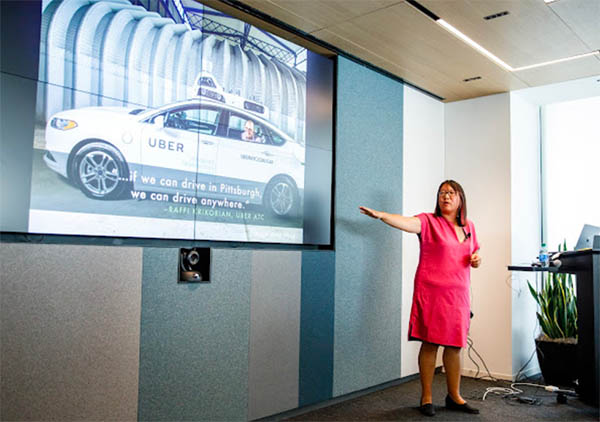

About the author
Oliver Mitchell is a partner at ff Venture Capital. His areas of focus are drones, robotics, and applied AI. Mitchell is also an adjunct professor at Yeshiva University. This column is reposted with permission.
Article topics
Email Sign Up

